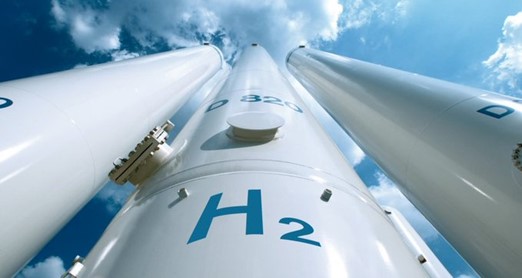SHINE Technologies’ headquarters building in Janesville, Wis. (Photo: SHINE)
The Department of Energy’s National Nuclear Security Administration has issued a cooperative agreement worth $35 million to SHINE Technologies, based in Janesville, Wis., to support the commercial production of molybdenum-99, a critical isotope used in more than 40,000 medical procedures in the United States each day, including the diagnosis of heart disease and cancer.
ORNL’s Benjamin Manard places a swipe on the extraction stage of Advion’s Plate Express, a microextraction tool that has been paired with a mass spectrometer. (Photo: Carlos Jones/ORNL, DOE)
International nuclear safeguards verification relies on a precise count of isotope particles collected on swipes during International Atomic Energy Agency inspections of nuclear facilities and isolated through a series of lengthy chemical separations that can take about 30 days to complete. On October 15, Oak Ridge National Laboratory—a member of the IAEA’s Network of Analytical Laboratories (NWAL)—announced that analytical chemists at the site have developed a faster way to measure isotopic ratios of uranium and plutonium collected on swipes, which could help IAEA analysts detect the presence of undeclared nuclear activities or material.
A PET imaging machine. (Photo: Wikimedia Commons)
ARTMS, a Canadian producer of medical isotopes, announced that it has registered the cyclotron production of gallium-68 with the government of Canada, filing a Type 1 Master File with the Health Products & Food Branch of Health Canada. The Ga-68 radioisotope is used in nuclear medicine diagnostic procedures utilizing positron emission tomography (PET) imaging.
Nuclear power capacity by scenario, 2020–2050 (STEPS: stated policies scenario, APS: announced pledges scenario, NZE: net-zero emissions by 2050 scenario). (Graphic: IEA World Energy Outlook 2021)
The International Energy Agency released its flagship report, World Energy Outlook 2021, on October 13, “at a time when policymakers are contending with the impacts of both climate change and volatile energy markets” and ahead of the COP26 Climate Change Conference in Glasgow, which begins October 31. With a net-zero emissions by 2050 (NZE) scenario that calls for nuclear power capacity to almost double by 2050, the report acknowledges that rapid development of advanced nuclear technologies could expand opportunities for nuclear energy to provide low-carbon electricity, heat, and hydrogen.
October 15, 2021, 3:26PMNuclear NewsMatt Palamara, Ali Fakhar, Stephen Smith, Patrick Fabian, Nathan Lang, and George Holoman Neutron noise monitoring allowed engineers to observe and interpret vibration characteristics captured by neutron flux detectors. (Photo: PSEG/Westinghouse)
The nuclear industry has historically relied on intermittent ultrasonic test and visual inspections of pressurized water reactor components to identify and manage degradation. While this reactive approach has proven to be effective, imagine a scenario in which the degradation could propagate throughout the reactor internals, making a more proactive measure necessary to avoid a major enterprise risk to the plant. Could a utility identify the onset of degradation within the reactor internals during plant operation? If so, could a repair be developed prior to the next refueling outage to prevent additional, cascading degradation? That is exactly the situation that Public Service Enterprise Group (PSEG) and Westinghouse engineers were able to navigate over the course of the 2019–2020 operating cycle at Salem Unit 1, resulting in a tremendous success for the plant and a historic landmark in the nuclear industry, while earning the team a 2021 Nuclear Energy Institute Top Innovative Practice (TIP) award.
Five sites have been shortlisted for the U.K.’s STEP fusion facility. (Image: UKAEA)
The United Kingdom has announced a shortlist of five sites as the potential future home of the U.K. Atomic Energy Authority’s (UKAEA) prototype fusion energy plant, the Spherical Tokamak for Energy Production (STEP). A final decision on the plant’s location is to be made by the U.K.’s secretary of state for business, energy and industrial strategy around the end of 2022.
The Darlington nuclear power plant.
The Canadian Nuclear Safety Commission has approved the renewal of the site preparation license for Ontario Power Generation’s Darlington new-build nuclear project. First granted in 2012, the license is now valid until October 11, 2031.
One of two Westinghouse AP1000 reactors to remain unfinished at the Summer nuclear power plant. (Photo: SCE&G)
Kevin Marsh, former chief executive officer and chairman of the board of directors of SCANA Corporation, has become the first person to be sentenced to prison for involvement in the 2017 collapse of the $10 billion Summer nuclear plant expansion project. Marsh was sentenced in federal court on October 7 and in state court on October 11.
The failure to complete the construction of two Westinghouse AP1000 reactors at the single-unit nuclear plant in Jenkinsville, S.C., cost ratepayers and investors billions, damaged the brands of then owners SCANA and Santee Cooper, and put some 6,000 people out of work.
Canada's Bruce nuclear power plant. (Photo: Chuck Szmurlo)
Canada’s Bruce Power, operator of the eight-unit Bruce nuclear power plant in Kincardine, Ontario, is undertaking a series of environmental initiatives to help attain its goal, announced in March, to achieve net-zero greenhouse gas emissions from site operations by 2027.
Balázs Bodnár, managing director of Framatome Hungary (left), shakes hands with Habil István András, rector of the University of Dunaújváros, joined by Ferenc Berki, president and CEO of Hunatom. (Photo: Framatome)
The Hungarian office of Framatome this week signed a memorandum of understanding with Budapest-based research and economic development company Hunatom and the University of Dunaújváros to work together supporting nuclear education and training, research and development, and implementation of new technologies for Hungary and surrounding countries.
Representatives of the three organizations signed the MOU during a ceremony at Hungary’s University of Dunaújváros, about 40 miles south of Budapest.















 The Minerals Council of Australia (MCA) last week released
The Minerals Council of Australia (MCA) last week released 




